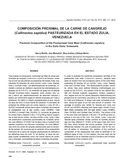Mostrar el registro sencillo del ítem
Composición proximal de la carne de cangrejo (Callinectes Sapidus) pasteurizada en el estado Zulia, Venezuela
| dc.rights.license | http://creativecommons.org/licenses/by-nc-sa/3.0/ve/ | |
| dc.contributor.author | Morillo, Nancy | |
| dc.contributor.author | Belandria, Jean | |
| dc.contributor.author | Andara, Mary | |
| dc.contributor.author | Berrio, Neliana | |
| dc.date.accessioned | 2010-05-28T15:15:06Z | |
| dc.date.available | 2010-05-28T15:15:06Z | |
| dc.date.issued | 2010-06-30 | |
| dc.identifier.issn | 0798-2259 | |
| dc.identifier.uri | http://www.saber.ula.ve/handle/123456789/31112 | |
| dc.description.abstract | Para evaluar la composición nutricional (g/100g) de carne pasteurizada de cangrejo (Callinectes sapidus) se tomaron muestras al azar de dos plantas procesadoras del estado Zulia, evaluándose 20 latas/tipo de corte (Jumbo Lump, Lump, Special, Claw y CocKtail Claw). Las determinaciones de proteínas, humedad y cenizas se realizaron siguiendo las metodologías propuestas por la A.O.A.C.; el contenido de grasa por el método Randall; minerales (calcio, magnesio, sodio, potasio, zinc, cobre y hierro) por espectrofotometría de absorción atómica y fósforo por colorimetría según el método propuesto por Fiske y Subbarow. Se utilizó un diseño completamente al azar, siendo los tipos de corte la única fuente de variación. El promedio de proteínas fue similar para los cortes Special y Lump (21,24 y 20,83%) mostrando ambos tipos mayor contenido de proteínas al compararlos con el tipo Jumbo Lump (19,99%), Claw (16,38%) y Cocktail Claw (18,42%). El contenido de grasa en los cortes Claw y Special (1,85 y 1,74 g/100 g) fueron superiores al resto de los cortes. Los tipos Jumbo Lump, Lump y Special presentaron contenidos porcentuales de humedad similares, pero difirieron (P<0,001) de los tipos Claw y Cocktail Claw, quienes mostraron los menores contenidos. No hubo diferencias entre los cortes de cangrejo pasteurizado para el contenido de cenizas. Se concluye que la variación de la composición nutricional de la carne de cangrejo pasteurizada es atribuida a los diferentes tipos de corte. En tal sentido, la carne de cangrejo puede considerarse como una fuente alterna de proteínas y minerales, acompañada de bajos contenidos de grasas. | es_VE |
| dc.language.iso | es | es_VE |
| dc.publisher | SABER ULA | es_VE |
| dc.rights | info:eu-repo/semantics/openAccess | |
| dc.subject | Callinectes sapidus | es_VE |
| dc.subject | Carne pasteurizada | es_VE |
| dc.subject | Composición proximal | es_VE |
| dc.title | Composición proximal de la carne de cangrejo (Callinectes Sapidus) pasteurizada en el estado Zulia, Venezuela | es_VE |
| dc.title.alternative | Proximal composition of the pasteurized crab meat (Callinectes Sapidus) in the Zulia state, Venezuela | es_VE |
| dc.type | info:eu-repo/semantics/article | |
| dc.description.abstract1 | In order to evaluate the nutritional composition (g/100g) of the pasteurized crab meat (Callinectes sapidus), samples were taken at random from two processors plants of the Zulia State, evaluating 20 tins/tips of cut (Jumbo Lump, Lump, Special, Claw and CocKtail Claw). The determinations protein, humidity, ashes, they were realized following methodologies proposed by the A.O.A.C., the content of fat by the method Randall, the minerals (calcium, magnesium, sodium, potassium, zinc, copper and iron) for atomic absorption espectroscopy and phosphorus for colorimetry according to the method proposed by Fiske and Subbarow. A design was used completely at random, being the types of cut the only source of variation. The average of proteins was similar for Special and Lump cuts (21.24 and 20.83%) showing both types major content of proteins when comparing with the type Jumbo Lump (19.99%), Claw (16.38%) and Cocktail Claw (18.42%). The content of fat in the cuts Claw and Special (1.85 and 1.74 g/100 g) were superiors to the rest of the cuts. The Jumbo Lump, Lump and Special types presented similar contents of humidity percentage, but they difiered (P <0.001) of the types Claw and Cocktail Claw, whom showed the minors contents. There were no differences between the cuts of pasteurized crab for the content of ashes. In conclusion, the variation of the nutritional composition of the pasteurized crab meat is attributed to the different types of cuts. To this respect, the crab meat can be considered to be an alternate source of proteins and minerals, accompanied of low contents of fat. | es_VE |
| dc.description.colacion | 306-311 | es_VE |
| dc.description.email | jbelandria7@yahoo.com | es_VE |
| dc.description.frecuencia | Bimestral | |
| dc.identifier.depositolegal | 199102ZU46 | |
| dc.publisher.pais | Venezuela | es_VE |
| dc.subject.institucion | Universidad del Zulia (LUZ) | es_VE |
| dc.subject.institucion | Universidad de Los Andes (ULA) | es_VE |
| dc.subject.keywords | Callinectes sapidus | es_VE |
| dc.subject.keywords | Pasteurized meat | es_VE |
| dc.subject.keywords | Proximal composition | es_VE |
| dc.subject.publicacionelectronica | Revista Científica | |
| dc.subject.seccion | Revista Científica: Tecnología de Alimentos | es_VE |
| dc.subject.thematiccategory | Medio Ambiente | es_VE |
| dc.subject.tipo | Revistas | es_VE |
| dc.type.media | Texto | es_VE |
Ficheros en el ítem
Este ítem aparece en la(s) siguiente(s) colección(ones)
-
Revista Científica - 2010 - Vol. XX - No. 003
Mayo - Junio 2010


